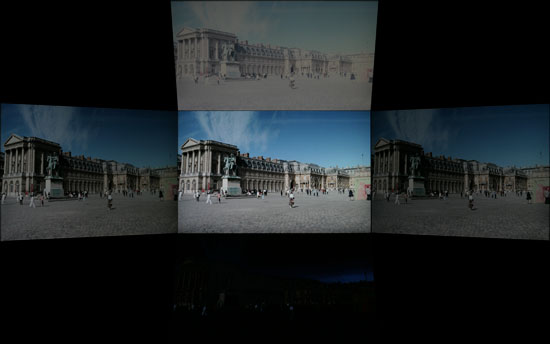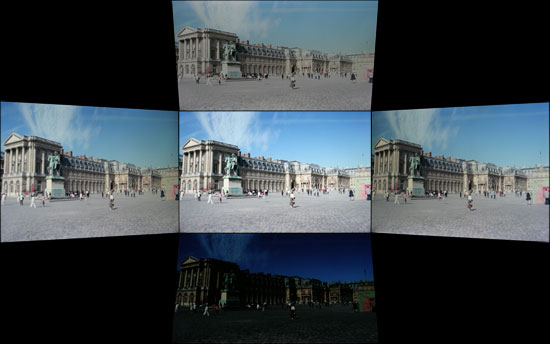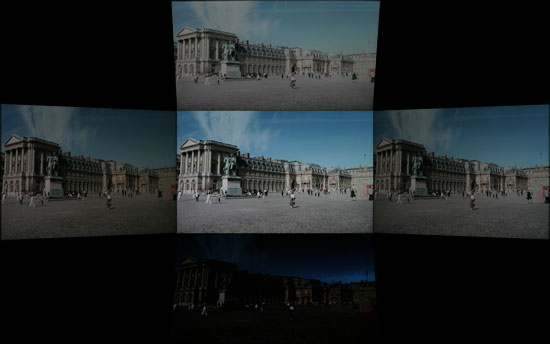Laptop LCD Roundup: Road Warriors Deserve Better
by Jarred Walton on May 22, 2007 5:00 AM EST- Posted in
- Displays
Viewing Angles
Viewing angles are one of those specifications that have become very inflated by the manufacturers. The basic requirement is that a display has to maintain a 10:1 contrast ratio in order to qualify as "viewable". The reality is that most LCDs are unfit for viewing outside of about a 45° arc, and on laptops you may not even get that much of a viewing arc. While we doubt that most people would want to view a display from an oblique angle, the typical positioning of a laptop - sitting on your lap only a couple feet from your eyes - can make viewing angles more important. Unfortunately, as all of the LCDs appear to use TN panels, that means viewing angles become more important and the technology becomes less satisfactory.
We used a Canon Digital Rebel SLR camera to take shots from head-on as well as from the left, right, top, and bottom at ~30° angles. We then combined the images into a single representative shot, showing how brightness and contrast ratios are affected in off-angle viewing. The camera was set to manual mode and an ISO value of 400 with an exposure time of 1/60s. While there's no substitute for actually sitting in front of a display yourself and using it, we did our best to use settings that generated images similar to what we saw in person. With all of the laptops photographed under the same conditions and with the same settings, the relative appearance of the images is at least as important as how each image looks individually.
Again, the ASUS G2P clearly comes out on top and offers the best overall viewing angles. The Dell XPS M1710 and MSI S271 are somewhat similar, though we would give the edge to the Dell laptop. The ASUS A8Js on the other hand ranks at the bottom, particularly in the areas of vertical viewing angles. On desktop systems, horizontal viewing angles are often more important, but in everyday use we find that vertical viewing angles are definitely a problem with many laptops. A slight tilt of your lap or a straightening of your back, and the perceived image can quickly become washed out.
Viewing angles are one of those specifications that have become very inflated by the manufacturers. The basic requirement is that a display has to maintain a 10:1 contrast ratio in order to qualify as "viewable". The reality is that most LCDs are unfit for viewing outside of about a 45° arc, and on laptops you may not even get that much of a viewing arc. While we doubt that most people would want to view a display from an oblique angle, the typical positioning of a laptop - sitting on your lap only a couple feet from your eyes - can make viewing angles more important. Unfortunately, as all of the LCDs appear to use TN panels, that means viewing angles become more important and the technology becomes less satisfactory.
We used a Canon Digital Rebel SLR camera to take shots from head-on as well as from the left, right, top, and bottom at ~30° angles. We then combined the images into a single representative shot, showing how brightness and contrast ratios are affected in off-angle viewing. The camera was set to manual mode and an ISO value of 400 with an exposure time of 1/60s. While there's no substitute for actually sitting in front of a display yourself and using it, we did our best to use settings that generated images similar to what we saw in person. With all of the laptops photographed under the same conditions and with the same settings, the relative appearance of the images is at least as important as how each image looks individually.
 ASUS A8Js  ASUS G2P  Dell XPS M1710  MSI S271 |
| Click to enlarge |
Again, the ASUS G2P clearly comes out on top and offers the best overall viewing angles. The Dell XPS M1710 and MSI S271 are somewhat similar, though we would give the edge to the Dell laptop. The ASUS A8Js on the other hand ranks at the bottom, particularly in the areas of vertical viewing angles. On desktop systems, horizontal viewing angles are often more important, but in everyday use we find that vertical viewing angles are definitely a problem with many laptops. A slight tilt of your lap or a straightening of your back, and the perceived image can quickly become washed out.










55 Comments
View All Comments
strikeback03 - Tuesday, May 22, 2007 - link
You actually need hardware as well as software for color calibration - IIRC the Monaco Optix system they use is somewhere in the $300-400 range. There are cheaper alternatives depending on what you need out of the package though.Skobbolop - Tuesday, May 22, 2007 - link
well... it's all about battery life is it not?... personally i think i would go for the low quality lcd with low power consumption, instead of the high quality LCD with high power requirements.... but that's just me :DJarredWalton - Tuesday, May 22, 2007 - link
I don't know... if darker lights save battery life (makes sense), why not just give users the option of dimming the lights when on battery power? The G2P allows a larger range of brightness than the others, though I didn't specifically test battery life at various settings. (3 hours per pass of a battery test can take a long time.) Anyway, I'd personally like to have both high quality and long battery life, with the ability to emphasize one depending on my current use of the laptop.bitacom - Wednesday, August 14, 2013 - link
jual lcd laptop, keyboard laptop, battery laptop, dan spare part laptopkunjungi
atau hubungi 0857 1166 5051
kami memberikan garansi 3 bulan
bitacom - Wednesday, August 14, 2013 - link
jual lcd laptop, keyboard laptop, battery laptop, dan spare part laptopkunjungi www. bitacom. asia
atau hubungi 0857 1166 5051
kami memberikan garansi 3 bulan